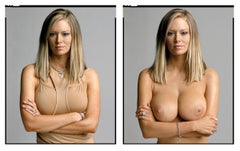Jenna Jameson
Early 2000s Pop Art Nude Photography
Color
People Also Browsed
Antique Late 19th Century British Decorative Boxes
Silver
21st Century and Contemporary Indian Nautical Objects
Aluminum, Steel
Early 1900s Impressionist Landscape Paintings
Canvas, Oil
Vintage 1940s Danish Hollywood Regency Sterling Silver
Gold Plate, Silver, Sterling Silver
2010s Italian Modern Wardrobes and Armoires
Chrome
1950s Modern Figurative Prints
Lithograph
1970s Contemporary Color Photography
Archival Ink, Archival Paper, Archival Pigment
21st Century and Contemporary French Games
Aluminum, Steel, Chrome
1980s Pop Art Portrait Prints
Board, Screen
21st Century and Contemporary Contemporary Figurative Prints
Archival Paper, Pigment
2010s Pop Art Figurative Sculptures
Ceramic, Automotive Paint
21st Century and Contemporary Contemporary Nude Photography
Archival Pigment
1950s Figurative Prints
Linocut
1990s Contemporary Black and White Photography
Photographic Film, Archival Paper, Photographic Paper, Black and White, ...
1990s French Modern Trunks and Luggage
Brass
20th Century Belgian Art Deco Musical Instruments
Wood
A Close Look at Pop Art Art
Perhaps one of the most influential contemporary art movements, Pop art emerged in the 1950s. In stark contrast to traditional artistic practice, its practitioners drew on imagery from popular culture — comic books, advertising, product packaging and other commercial media — to create original Pop art paintings, prints and sculptures that celebrated ordinary life in the most literal way.
ORIGINS OF POP ART
- Started in Britain in the 1950s, flourished in 1960s-era America
- “This is Tomorrow,” at London's Whitechapel Gallery in 1956, was reportedly the first Pop art exhibition
- A reaction to postwar mass consumerism
- Transitioning away from Abstract Expressionism
- Informed by neo-Dada and artists such as Jasper Johns and Robert Rauschenberg; influenced postmodernism and Photorealism
CHARACTERISTICS OF POP ART
- Bold imagery
- Bright, vivid colors
- Straightforward concepts
- Engagement with popular culture
- Incorporation of everyday objects from advertisements, cartoons, comic books and other popular mass media
POP ARTISTS TO KNOW
- Richard Hamilton
- Andy Warhol
- Marta Minujín
- Claes Oldenburg
- Eduardo Paolozzi
- Rosalyn Drexler
- James Rosenquist
- Peter Blake
- Roy Lichtenstein
ORIGINAL POP ART ON 1STDIBS
The Pop art movement started in the United Kingdom as a reaction, both positive and critical, to the period’s consumerism. Its goal was to put popular culture on the same level as so-called high culture.
Richard Hamilton’s 1956 collage Just what is it that makes today’s homes so different, so appealing? is widely believed to have kickstarted this unconventional new style.
Pop art works are distinguished by their bold imagery, bright colors and seemingly commonplace subject matter. Practitioners sought to challenge the status quo, breaking with the perceived elitism of the previously dominant Abstract Expressionism and making statements about current events. Other key characteristics of Pop art include appropriation of imagery and techniques from popular and commercial culture; use of different media and formats; repetition in imagery and iconography; incorporation of mundane objects from advertisements, cartoons and other popular media; hard edges; and ironic and witty treatment of subject matter.
Although British artists launched the movement, they were soon overshadowed by their American counterparts. Pop art is perhaps most closely identified with American Pop artist Andy Warhol, whose clever appropriation of motifs and images helped to transform the artistic style into a lifestyle. Most of the best-known American artists associated with Pop art started in commercial art (Warhol made whimsical drawings as a hobby during his early years as a commercial illustrator), a background that helped them in merging high and popular culture.
Roy Lichtenstein was another prominent Pop artist that was active in the United States. Much like Warhol, Lichtenstein drew his subjects from print media, particularly comic strips, producing paintings and sculptures characterized by primary colors, bold outlines and halftone dots, elements appropriated from commercial printing. Recontextualizing a lowbrow image by importing it into a fine-art context was a trademark of his style. Neo-Pop artists like Jeff Koons and Takashi Murakami further blurred the line between art and popular culture.
Pop art rose to prominence largely through the work of a handful of men creating works that were unemotional and distanced — in other words, stereotypically masculine. However, there were many important female Pop artists, such as Rosalyn Drexler, whose significant contributions to the movement are recognized today. Best known for her work as a playwright and novelist, Drexler also created paintings and collages embodying Pop art themes and stylistic features.
Read more about the history of Pop art and the style’s famous artists, and browse the collection of original Pop art paintings, prints, photography and other works for sale on 1stDibs.
Finding the Right Figurative-photography for You
Life becomes art in figurative photography. Shared moments are captured and history is recorded in images of people and their lives.
Figurative photography is often used to describe a kind of photography in which people are the subject. Early black and white photography of people can be a glimpse into a past century — witness the celebrated work of photographers such as Ansel Adams or lesser-known artists like Berenice Abbott, for example. The cultural and social standards of the time are captured in these figurative photographs.
Mid-century photos might show the life and fashions of the day, sometimes with the shared thread of humanity, joy and love. Indeed, figurative photographs can be a source of inspiration and wonder, speaking of common life experiences and beauty. Vintage photos of celebrities and iconic actors can be valuable keepsakes as snapshots of a bygone era.
Just as if you were bringing paintings, prints or drawings into your space as part of the decor, there are many ways to arrange your figurative photography. Large photos can be statement pieces in a room. Smaller photographs can be placed on bookcases or on compact wall spaces to add an artistic element to a living room or a bedroom.
Find a collection of figurative photography on 1stDibs today.
